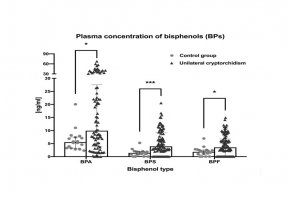In July 2021, a team of researchers and collaborators from the Department of Pediatric Surgery and Urology, Medical University of Bialystok, published in the journal Frontiers in Endocrinology (https: / /pubmed.ncbi.nlm.nih.gov/34335471/) an article entitled "Identification of the Bisphenol A (BPA) and the Two Analogues BPS and BPF in Cryptorchidism".
This is the first study in the world reporting the concentration of selected bisphenols (BPA, BPS, and BPF) in the blood serum of boys with undescended testes.
Cryptorchidism, the failure of the testicles to descend, is the most common congenital defect of the genitourinary system. It affects from 2 to 4% of full-term newborns. The condition is most commonly regarded as idiopathic (of unknown origin). Therefore, new risk factors for its development are continually investigated.
Endocrine Disrupting Chemicals (EDCs) are exogenous chemicals that interfere with the functioning of the human endocrine system. They include, for instance: phytoestrogens, dioxins, phthalates, bisphenol A, heavy metals, pesticides, e.g. dichlorodiphenyltrichlorethane (DDT), and many others.
Bisphenol A (BPA) is one of the best-described EDCs. It is a component of polycarbonates, used in the mass production of plastic materials, including plastic packaging for food storage, PET bottles, toys, or epoxy resins used in the production of aluminum cans. BPA is also an ingredient of thermal paper used in the production of receipts, bank prints, and cosmetics. BPA, as a xenoestrogen, mimics estrogens, female sex hormones, which may adversely affect the functioning of the endocrine system, especially in males. BPA has been found in samples of human urine, blood, saliva, breast milk, semen, ovarian follicular fluid, and adipose tissue.
Due to the increasing number of reports on the adverse impact of the substance on the population, manufacturers are trying to replace BPA with new analogues, including bisphenol BPS and BPF, which can be used as components in the so-called "BPA free" products. Although the new forms of BPA have a similar chemical structure, there are few reports in the world about the impact of BPA analogues on the human body.
It was shown for the first time that the concentration of all three bisphenols was significantly higher in children with cryptorchidism than in the control group. Our unique results shed new light on the etiopathogenesis of testicular descent disorders. Interestingly, higher concentrations of bisphenols were recorded among children from urbanized areas. The publication is a continuation of a pioneering series of papers on the effects of bisphenol A on the male reproductive system (https://pubmed.ncbi.nlm.nih.gov/26491444/, https://pubmed.ncbi.nlm.nih.gov/31093279/). In the future, the research will determine the effect of xenoestrogens on the risk of developing other selected congenital birth defects.





